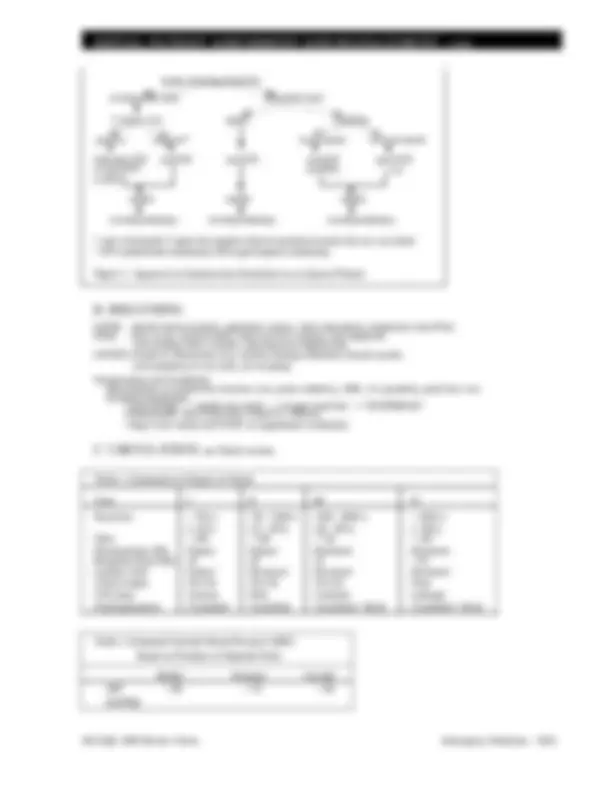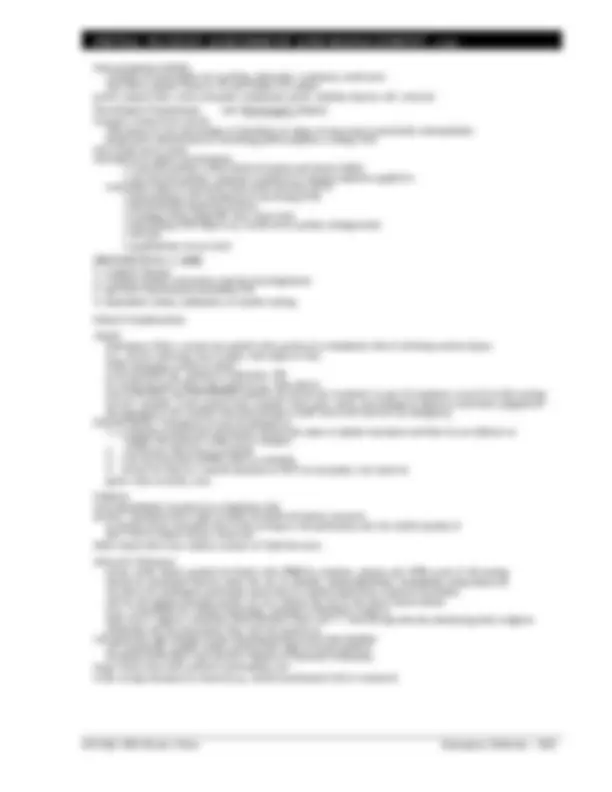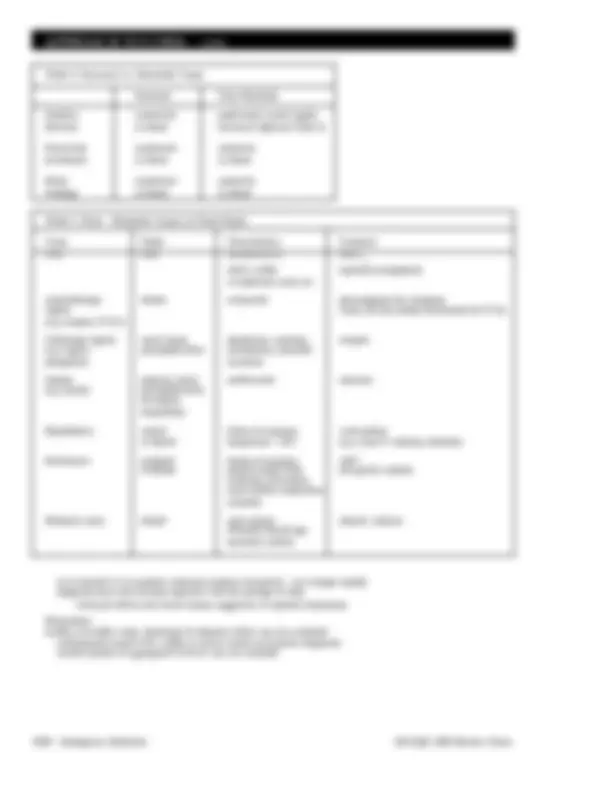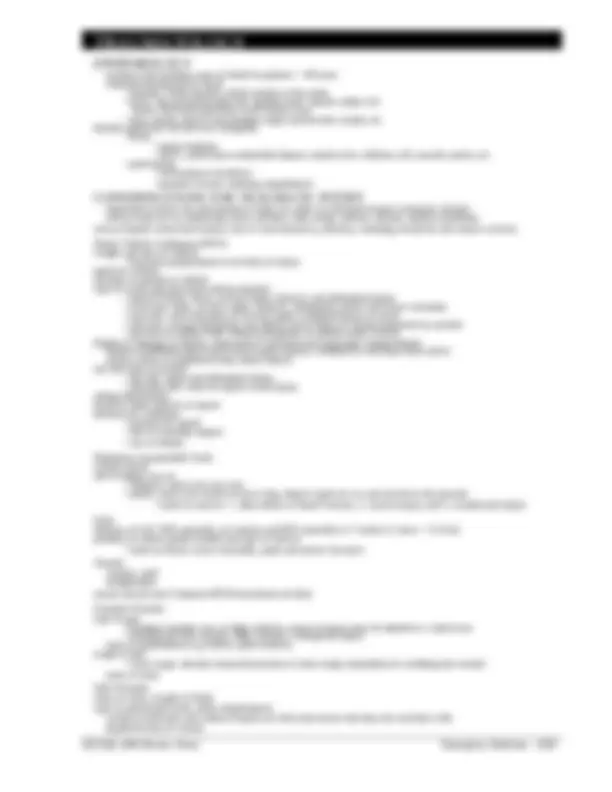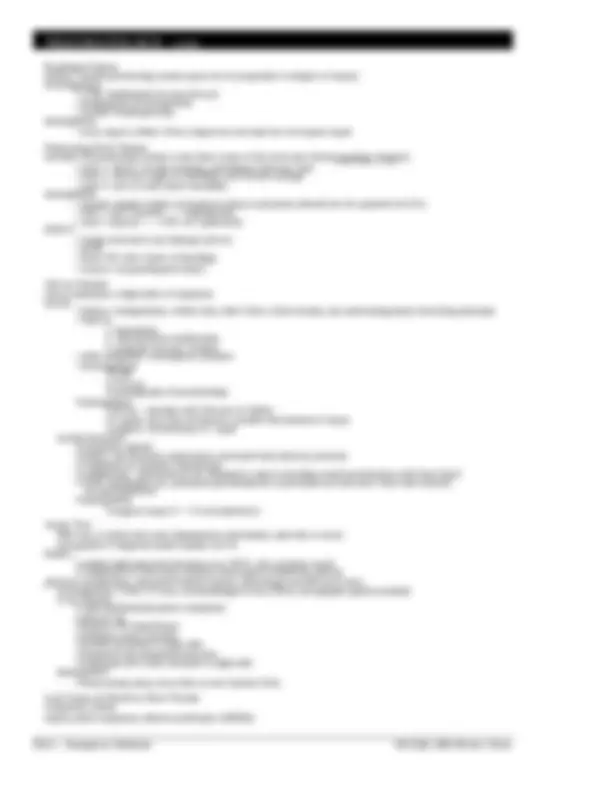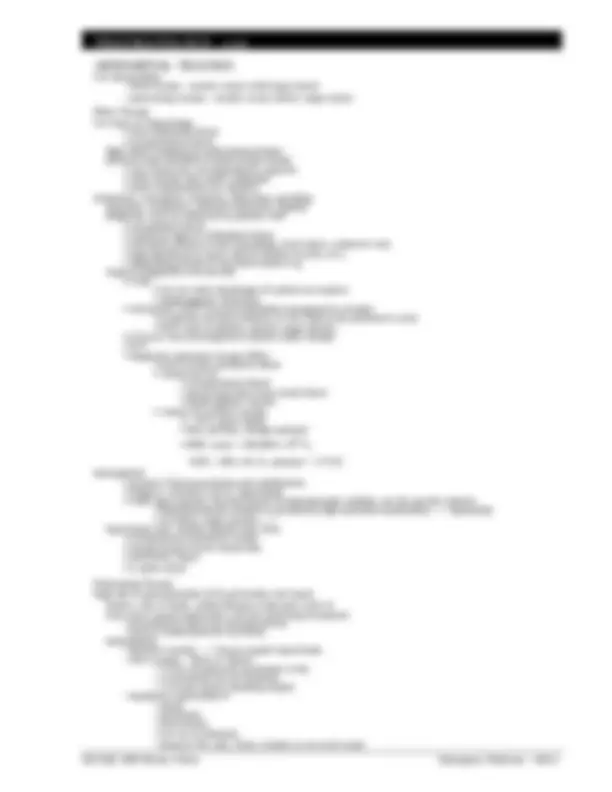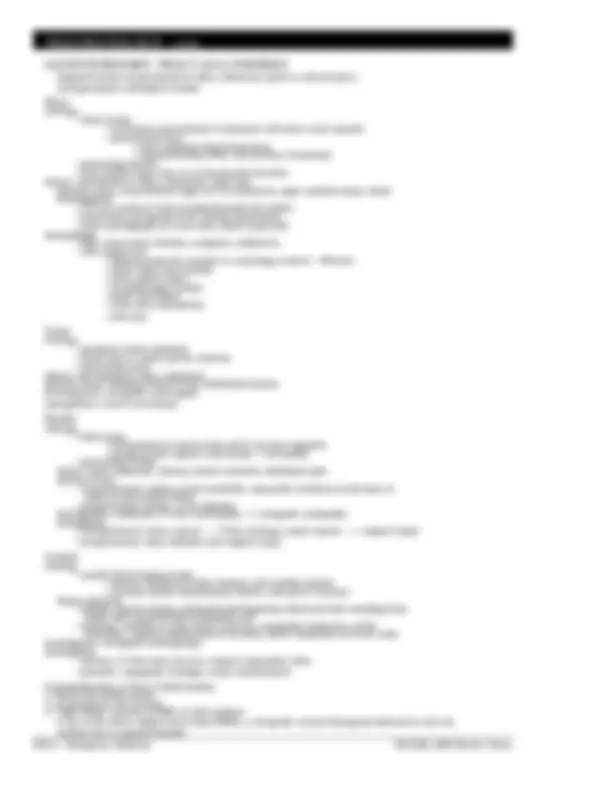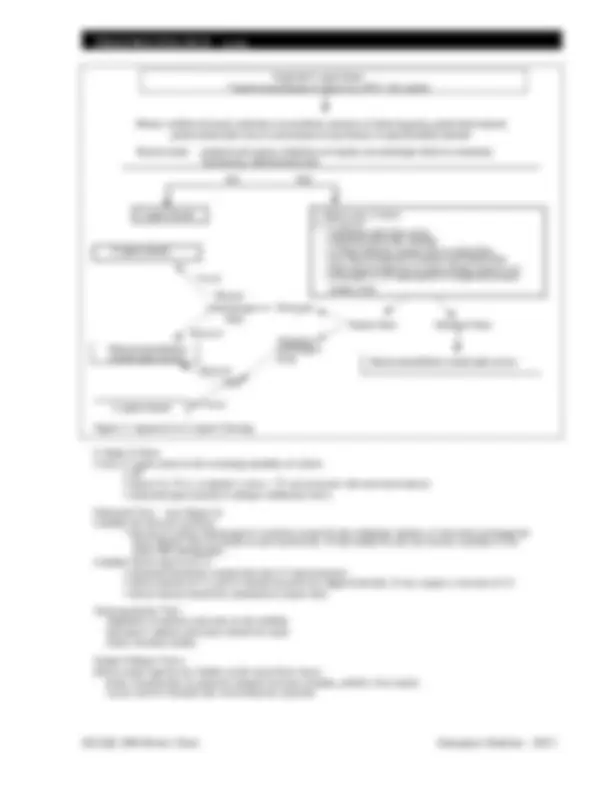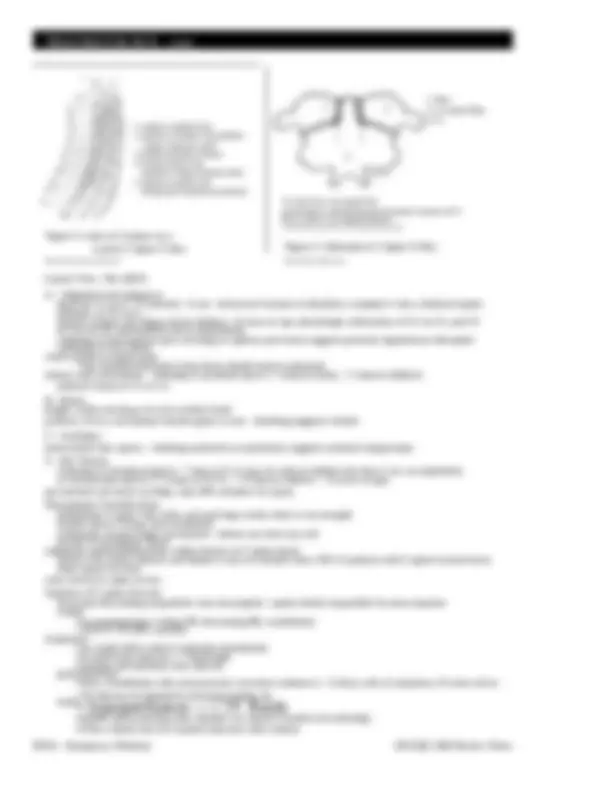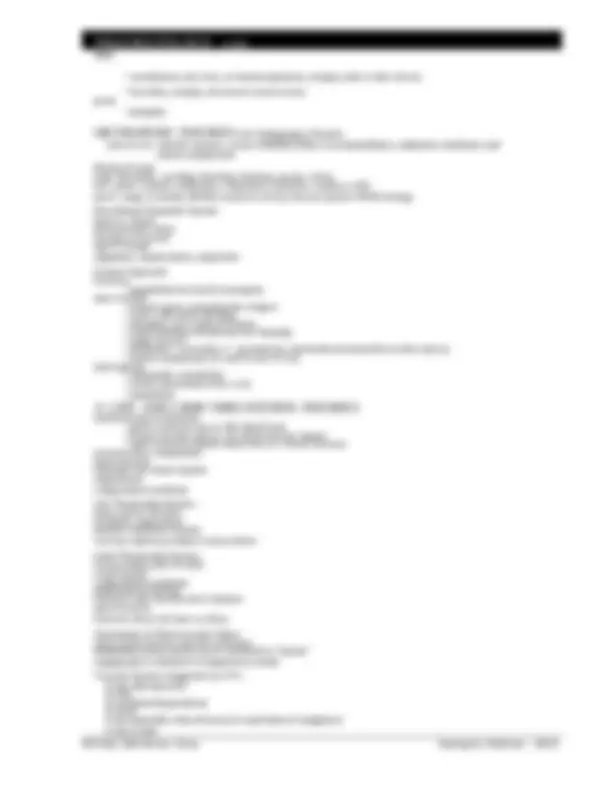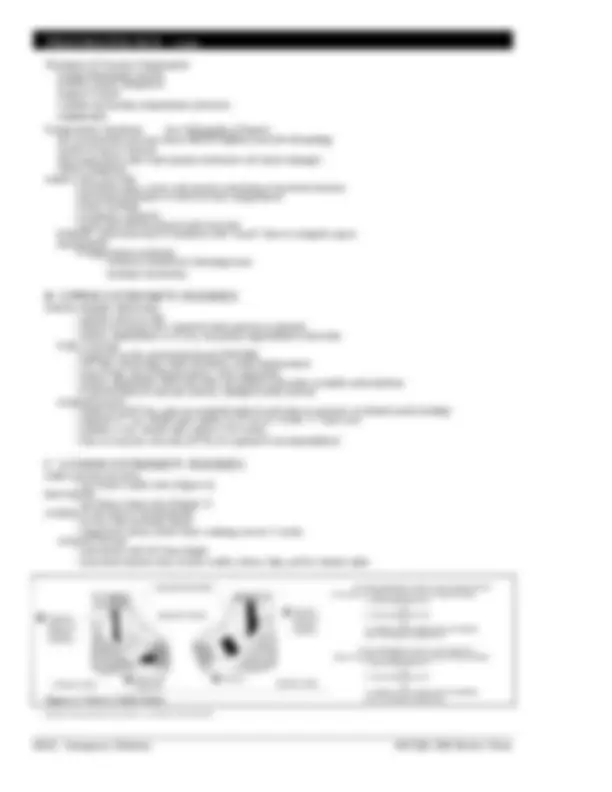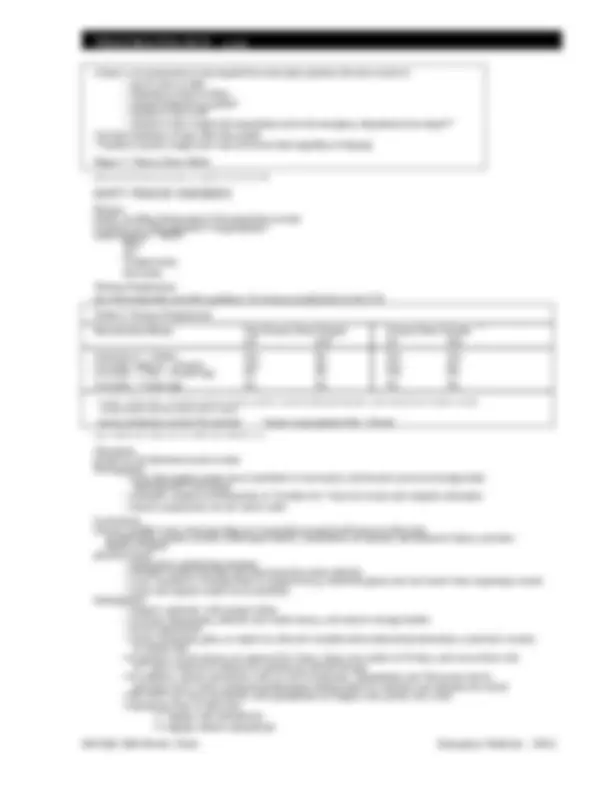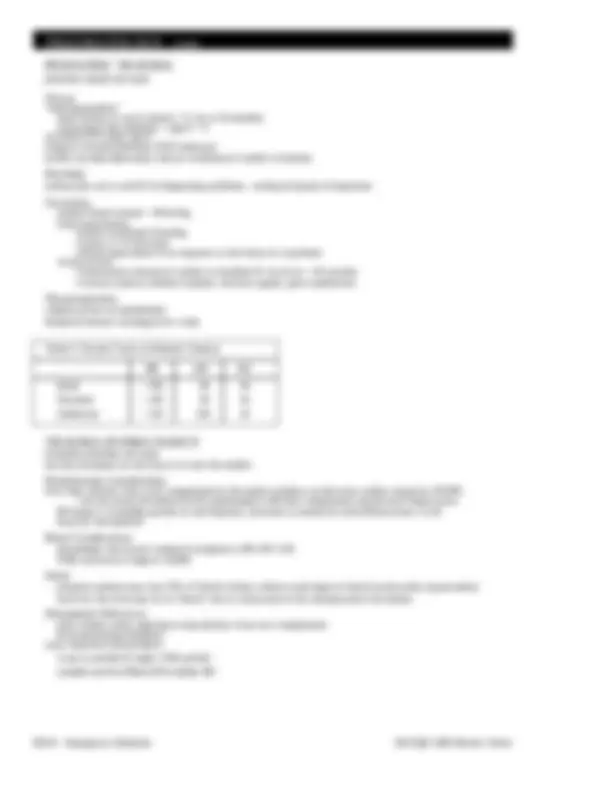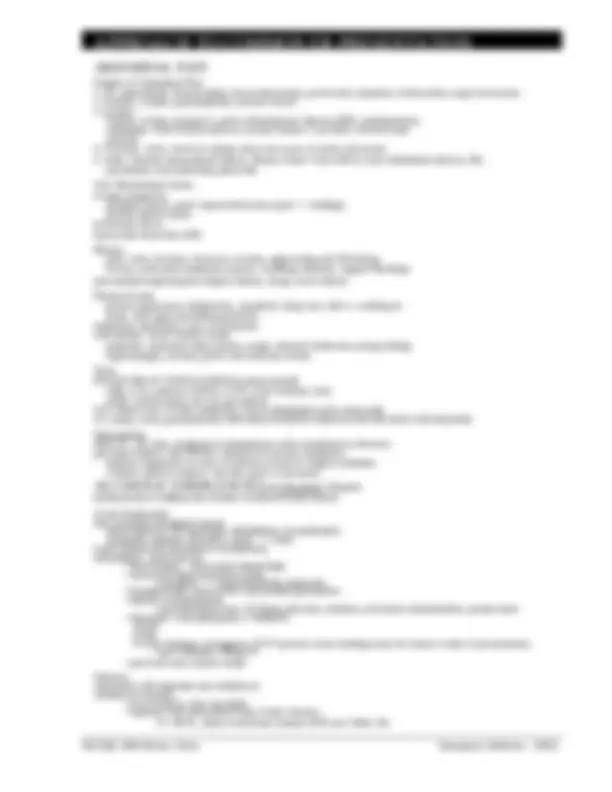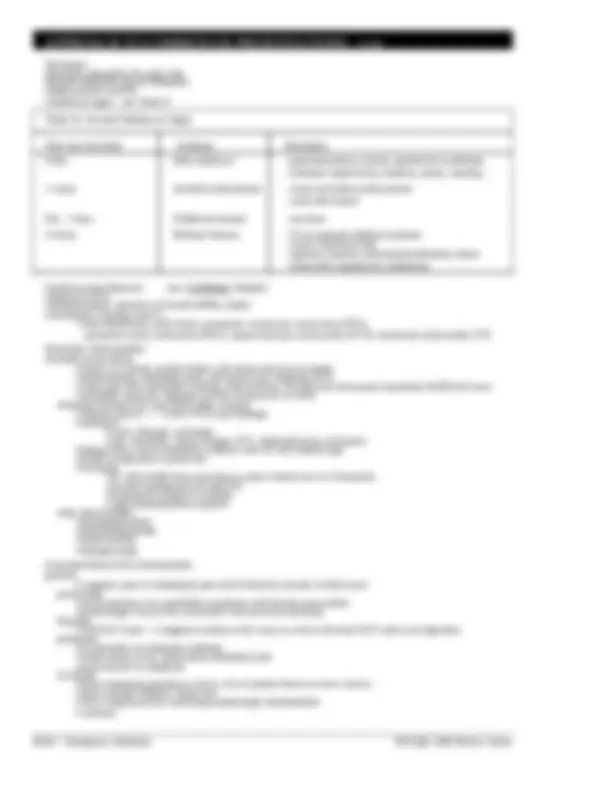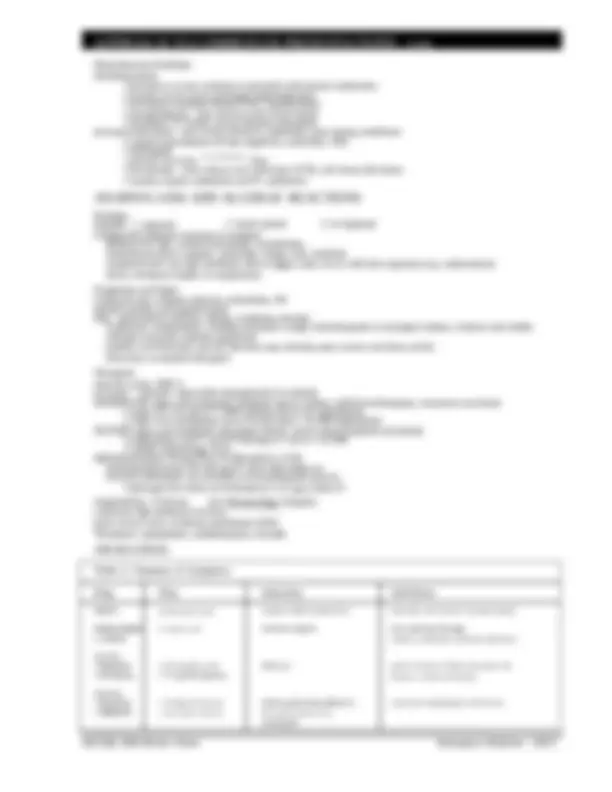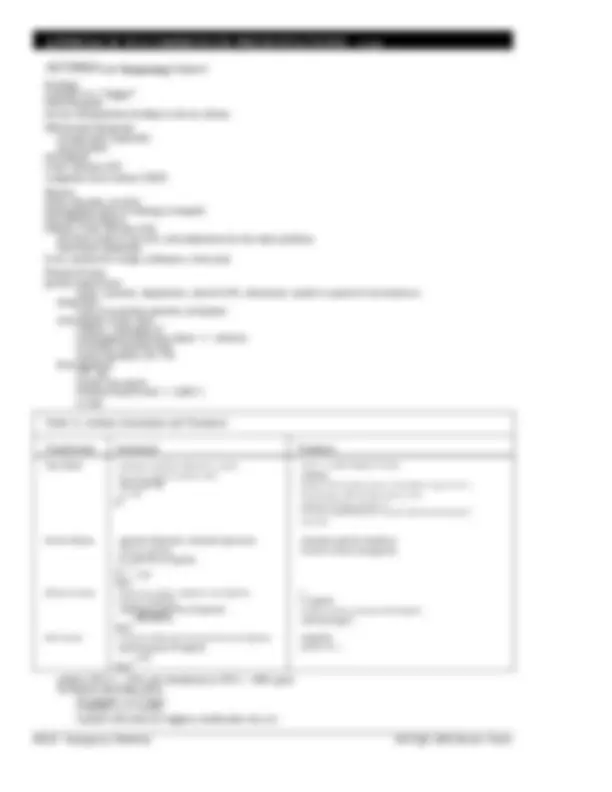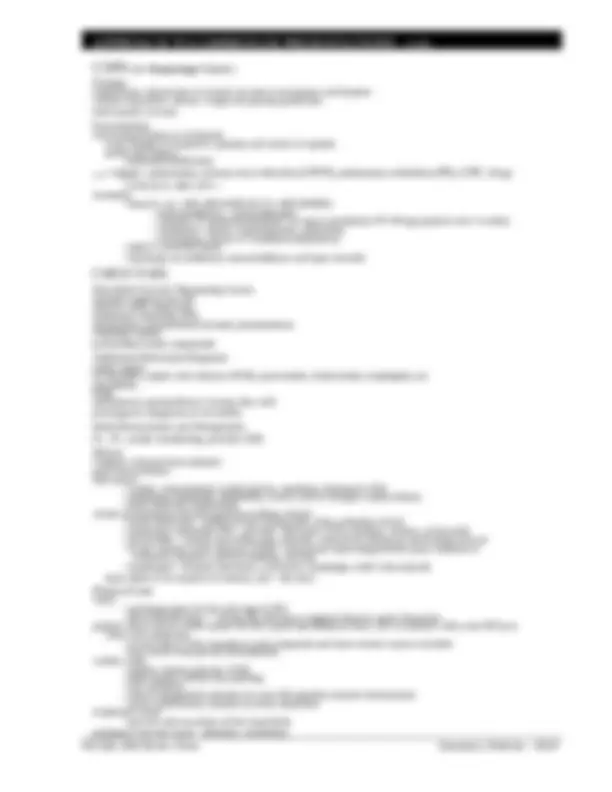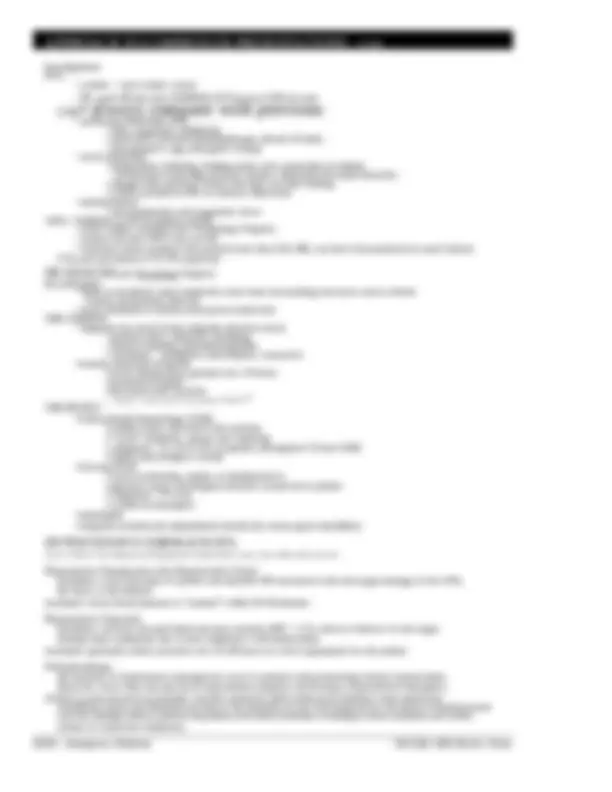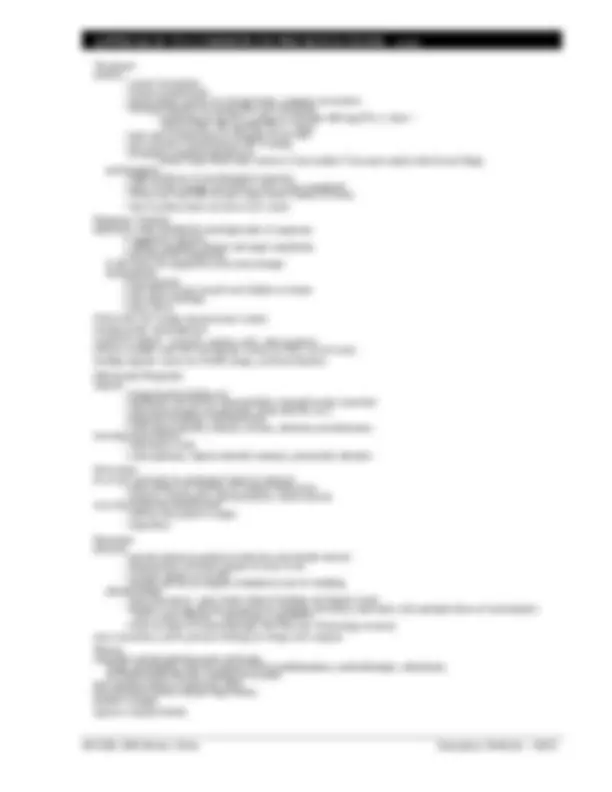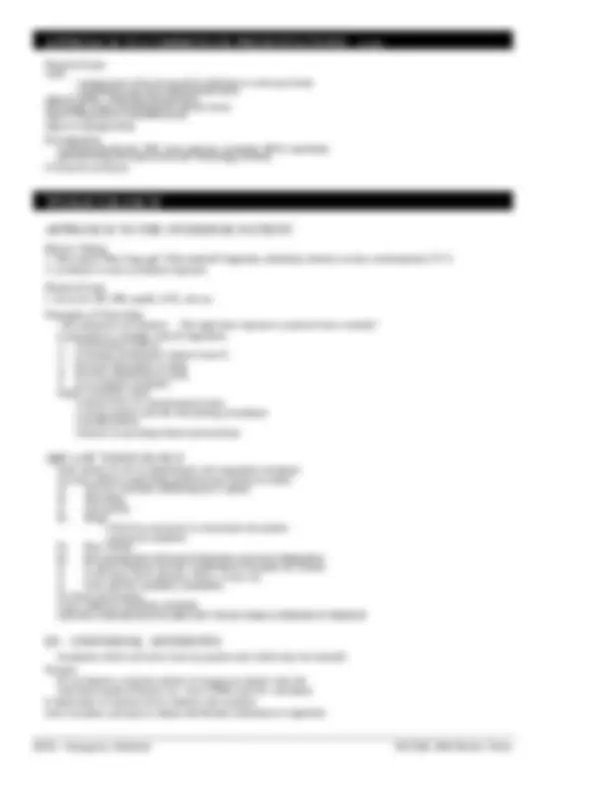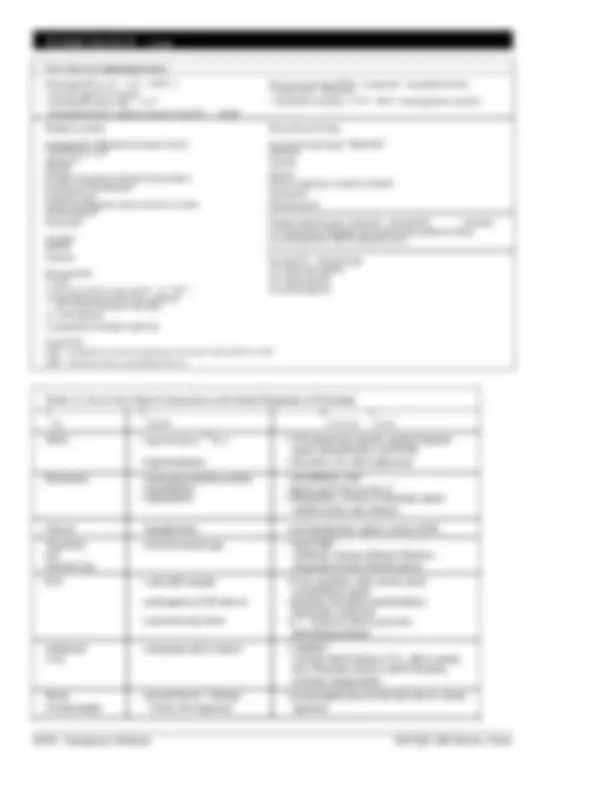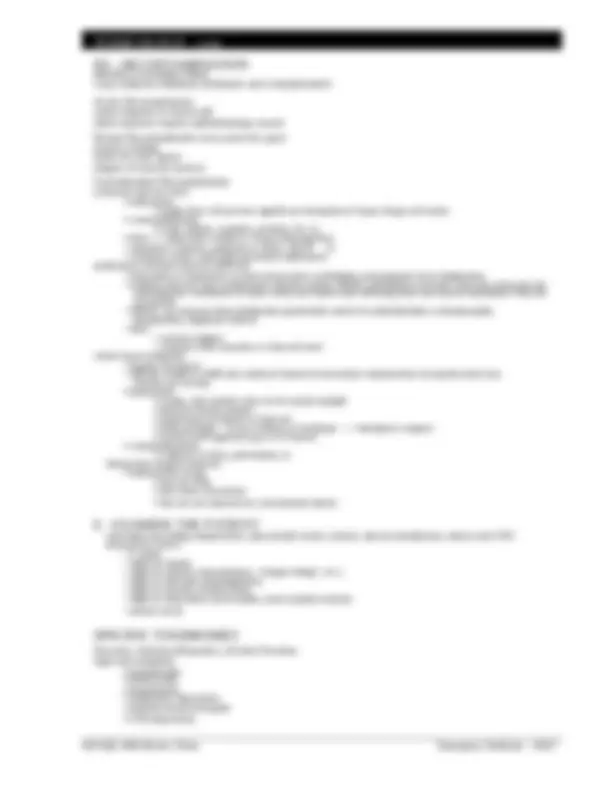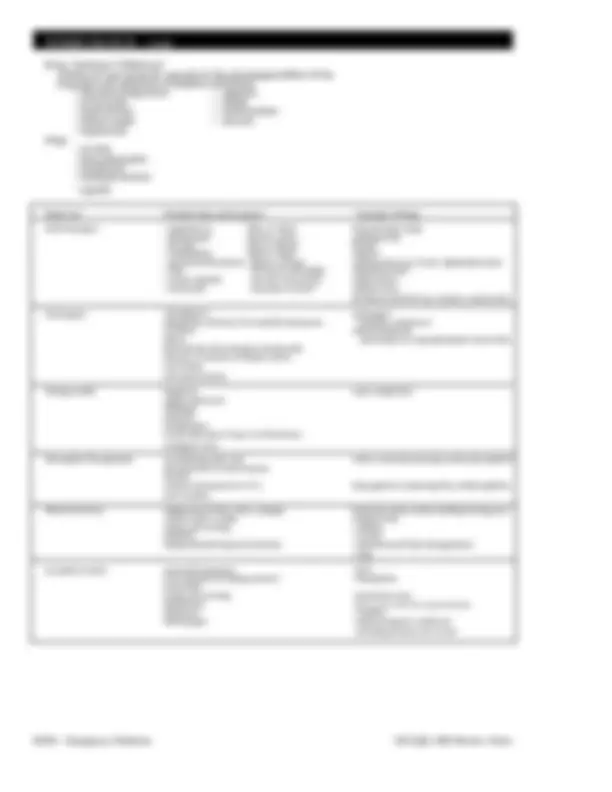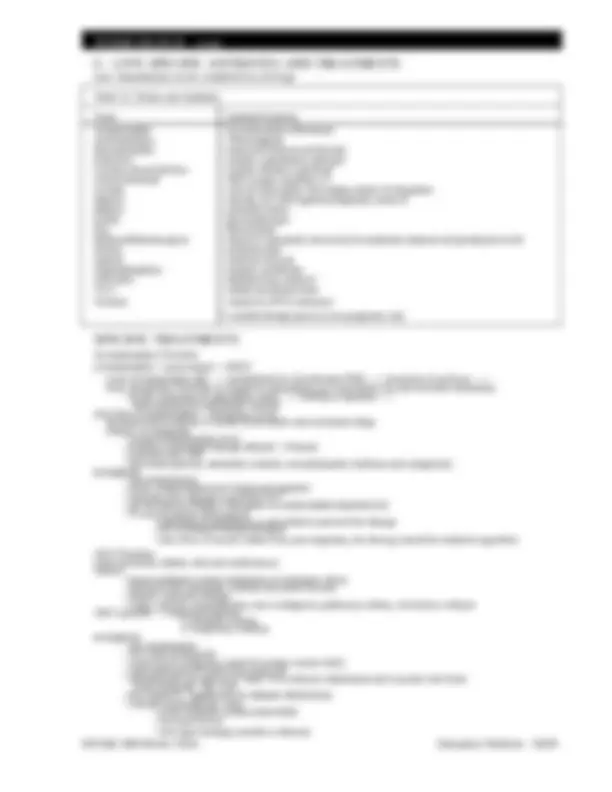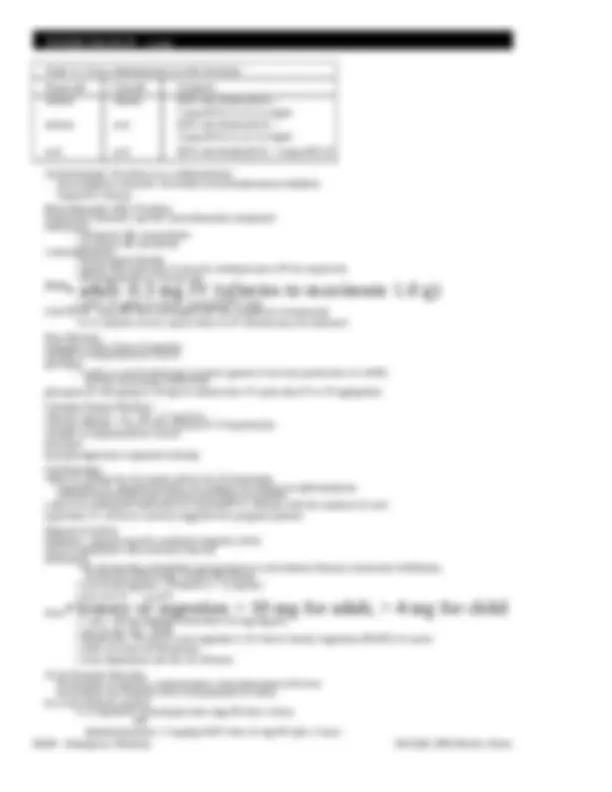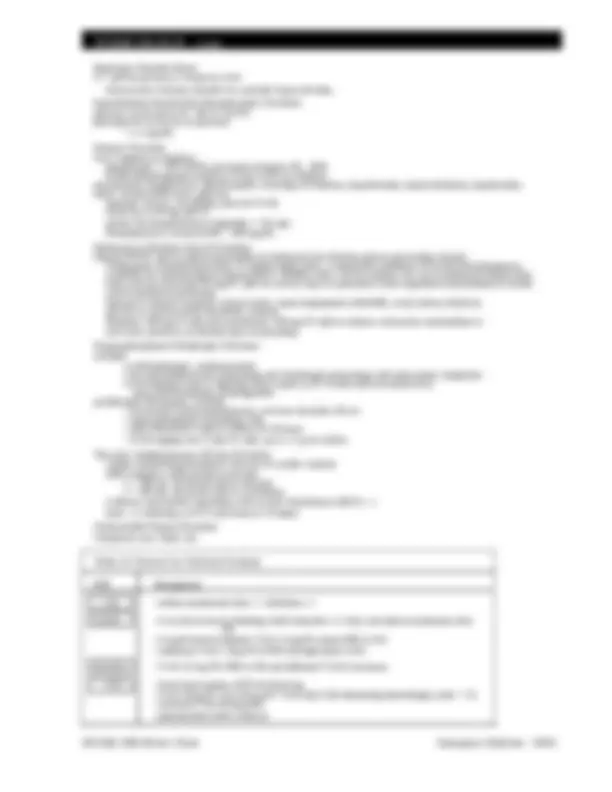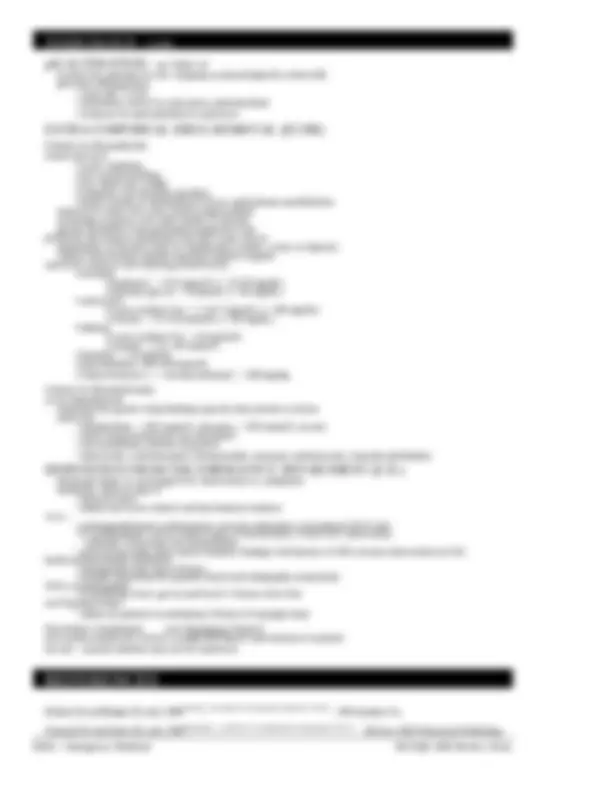Download Traumatic Injuries: Identification and Management and more Exams Nursing in PDF only on Docsity!
EMT Paramedics and EMS EMERGENCY MEDICINE
INITIAL PATIENT ASSESSMENT...........
AND MANAGEMENT
Approach Prioritized Plan Rapid Primary Survey A. Airway B. Breathing C. Circulation D. Disability E. Exposure/Environment Resuscitation Detailed Secondary Survey Definitive Care
PRE-HOSPITALCARE ......................
Level of Providers
APPROACHTOCOMA ....................
Glasgow Coma Scale (GCS) Management of the Comatose Patient
TRAUMATOLOGY..........................
Epidemiology Considerations for Traumatic Injury Shock in the Trauma Patient Chest Trauma A. Immediately Life-Threatening Chest Injuries B. Potentially Life-Threatening Chest Injuries Abdominal Trauma Genitourinary (GU) Tract Injuries Head Trauma Spine and Spinal Cord Trauma Approach to Suspected C-Spine Injury Orthopedic Injuries A. Life and Limb Threatening Injuries B. Upper Extremity Injuries C. Lower Extremity Injuries Soft Tissue Injuries Environmental Injuries Pediatric Trauma Trauma in Pregnancy
2 APPROACHTOCOMMONER .............. 25
PRESENTATIONS
Abdominal pain Alcoholic Emergencies Anaphylaxis and Allergic Reactions Analgesia Asthma Chronic Obstructive Pulmonary Disease (COPD) Chest Pain Headache Hypertensive Emergencies Status Epilepticus Syncope Sexual Assault and Domestic Violence 6 Violent Patient
TOXICOLOGY ............................. 34
6 Approach to the Overdose Patient ABCs of Toxicology D 1 - Universal Antidotes D 2 - Draw Bloods 9 D 3 - Decontamination E
- Examine the Patient Specific Toxidromes G - Give Specific Antidotes and Treatment Specific Treatments pH Alteration Extra-Corporeal Drug Removal Disposition from the Emergency Department
REFERENCES ............................. 42
MCCQE 2006 Review Notes Emergency Medicine – ER
INITIAL PATIENT ASSESSMENT AND MANAGEMENT
APPROACH
5 level triage (new Canadian Guidelines)
- I Resuscitation
- II Emergent
- III Urgent
- IV Less-urgent
- V Non-urgent
PRIORITIZED PLAN
- Rapid Primary Survey (RPS)
- Resuscitation (often occurs at same time as RPS)
- Detailed Secondary Survey
- Definitive Care
RAPID PRIMARY SURVEY (RPS)
Airway maintenance with C-spine control Breathing and ventilation Circulation (pulses, hemorrhage control) Disability (neurologic status) E xposure (complete) and E nvironment (temperature control) restart sequence from beginning if patient deteriorates
A. AIRWAY
first priority is to secure airway assume a cervical (C-spine) injury in every trauma patient ––> immobilize with collar and sand bags
Causes of Airway Obstruction decreased level of consciousness (LOC) airway lumen: foreign body (FB), vomit airway wall: edema, fractures external to wall: lax muscles (tongue), direct trauma, expanding hematoma Airway Assessment assess ability to breathe and speak signs of obstruction
- noisy breathing is obstructed breathing until proven otherwise
- respiratory distress
- failure to speak, dysphonia
- adventitous sounds
- cyanosis
- agitation, confusion, “universal choking sign” think about ability to maintain patency in future can change rapidly, ALWAYS REASSESS Airway Management
goals
• achieve a reliably patent airway
- permit adequate oxygenation and ventilation
- facilitate ongoing patient management
- give drugs via endotracheal tube (ETT) if IV not available
- NAVEL: Narcan, Atropine, Ventolin, Epinephrine, Lidocaine start with basic management techniques then progress to advanced
- Basic Management (Temporizing Measures) protect the C-spine chin lift or jaw thrust to open the airway sweep and suction to clear mouth of foreign material nasopharyngeal airway oropharyngeal airway (not if gag present) transtracheal jet ventilation (through cricothyroid membrane)
- used as last resort, if unable to ventilate after using above techniques
- Definitive Airway endotracheal intubation (ETT) (see Figure 1)
- orotracheal +/– Rapid Sequence Intubation (RSI)
- nasotracheal - may be better tolerated in conscious patient
- does not provide 100% protection against aspiration indications for intubation
- unable to protect airway
- inadequate spontaneous ventilation
- O 2 saturation < 90% with 100% O 2
•GCS=
- anticipate in trauma, overdose, congestive heart failure (CHF), asthma, and chronic obstructive pulmonary disease (COPD)
- anticipated transfer of critically ill patients surgical airway (if unable to intubate using oral/nasal route)
- needed for chemical paralysis of agitated patients for investigations
- cricothyroidotomy
ER2 – Emergency Medicine MCCQE 2006 Review Notes
INITIAL PATIENT ASSESSMENT AND MANAGEMENT... CONT.
stop major external bleeding
- apply direct pressure
- elevate profusely bleeding extremities if no obvious unstable fracture
- consider pressure points (brachial, axillary, femoral)
- do not remove impaled objects as they tamponade bleeding
- use tourniquet as last resort treatment
- 2 large bore peripheral IV’s for shock (14-16 gauge)
- bolus with Ringer’s lactate (RL) or normal saline (NS) (2 litres) and then blood as indicated for hypovolemic shock
- inotropes for cardiogenic shock
- vasopressors for septic shock
D. DISABILITY assess level of consciousness by AVPU method (quick, rudimentary assessment) A - ALERT V - responds toVERBAL stimuli P - responds toU - U P AINFUL stimuli NRESPONSIVE size and reactivity of pupils
movement of upper and lower extremities (UE/LE)
E. EXPOSURE / ENVIRONMENT
undress patient completely essential to assess all areas for possible injury keep patient warm with a blanket +/– radiant heaters; avoid hypothermia
RESUSCITATION restoration of ABCs manage life-threatening problems as they are identified often done simultaneously with primary survey vital signs q 5-15 minutes ECG, BP and O 2 monitors Foley catheter and nasogastric (NG) tube if indicated
- Foley contraindicated if blood from urethral meatus or other signs of urethral tear (see Traumatology section)
- NG tube contraindicated if significant mid-face trauma or basal skull fracture • may use orogastric tube order appropriate tests and investigations: may include CBC, lytes, BUN, Cr, glucose, amylase, INR/PTT, ß-HCG, tox screen, cross + type DETAILED SECONDARY SURVEY done after RPS problems have been corrected designed to identify major injuries or areas of concern head to toe physical exam and X-rays (C-spine, chest, pelvis - required in blunt trauma)
History “AMPLE ”: Allergies, M edications, P ast medical history, Last meal, Events related to injury
Head and Neck pupils
- assess equality, size, symmetry, reactivity to light
- inequality suggests local eye problem or lateralizing CNS lesion
- reactivity/level of consciousness (LOC)
- reactive pupils + decreased LOC ––> metabolic or structural cause
- non-reactive pupils + decreased LOC ––> structural cause
- extraocular movements (EOM’s) and nystagmus
- fundoscopy (papilledema, hemorrhages) palpation of facial bones, scalp tympanic membranes
Chest flail segment, contusion subcutaneous emphysema auscultate lung fields CXR
Abdomen inspection, palpation, percussion, auscultation immediate laparotomy if
- refractory shock with no other discernable cause
- obvious peritonitis
- increasingly distended abdomen
- positive diagnostic peritoneal lavage/CT scan rectal exam for gastrointestinal (GI) bleed, high riding prostate and anal tone bimanual exam in females
ER4 – Emergency Medicine MCCQE 2006 Review Notes
INITIAL PATIENT ASSESSMENT AND MANAGEMENT... CONT.
Musculoskeletal (MSK) examine all extremities for swelling, deformity, contusion, tenderness log rolled, palpate thoracic (T) and lumbar (L)-spines pelvis: palpate iliac crests and pubic symphysis, pelvic stability (lateral, AP, vertical) Neurological Examination (see Neurosurgery Chapter) Glasgow Coma Scale (GCS) alterations of rate and rhythm of breathing are signs of structural or metabolic abnormalities progressive deterioration of breathing pattern implies a failing CNS full cranial nerve exam assessment of spinal cord integrity
- conscious patient: assess distal sensation and motor ability
- unconscious patient: response to painful or noxious stimulus applied to extremities signs of increased intracranial pressure (ICP)
- deteriorating LOC (hallmark of increasing ICP)
- deteriorating respiratory pattern
- Cushing reflex (high BP, slow heart rate)
- lateralizing CNS signs (e.g. cranial nerve palsies, hemiparesis)
- seizures
- papilledema (occurs late)
DEFINITIVE CARE
- continue therapy
- continue patient evaluations (special investigations)
- specialty consultations including O.R.
- disposition: home, admission, or another setting
Ethical Considerations
Adults Emergency Rule: consent not needed when patient is at imminent risk of suffering serious injury (i.e., severe suffering, loss of limb, vital organ or life) AND obtaining consent is either: a) not possible (eg., patient is comatose), OR b) would increase risk to the patient (e.g., time delay) any CAPABLE and INFORMED patient can refuse any treatment or part of treatment, even if it is life-saving in E.D. consider: is the patient truly capable? does pain, stress, psychological distress cloud their judgement? the emergency rule assumes that most people would want to be saved in an emergency EXCEPTIONS: Treatment can not be initiated if:
- a competent patient has previously refused the same or similar treatment and there is no evidence to suggest the patient's wishes have changed
- an advance directive is available
- a do not resucitate (DNR) order is available
- refusal for help in a suicide situation is NOT an exception; care must be given when in doubt, treat
Children treat immediately if patient is at imminent risk parents / guardians have right to make treatment decisions, however if parents refuse treatment that is life-saving or will potentially alter the child's quality of life, CAS is almost always contacted MDs cannot then treat without consent of Child Services
Jehovah's Witnesses refuse whole blood, packed red blood cells (PRBCs), platelets, plasma and WBCs even if life-saving should be questioned directly about the use of albumin, immunoglobulins, hemophillic preparations do not allow for autollogous transfusion unless there is uninterrupted extra corporeal circulation ask for the highest possible quality of care without the use of the above interventions (e.g., crystalloids for volume expansion, attempts at bloodless surgery) may carry a signed, witnessed, dated Medical Alert card +/– bracelet specifically identifying their religious affiliation and the procedures they will not consent to will generally sign hospital forms releasing medical staff from liability are consenting, capable adults and have the right to refuse medical treatment most legal cases involve children of Jehovah's Witnesses large centres may have policies surrounding care if life-saving treatment is refused (e.g., blood transfusion) CAS is contacted
MCCQE 2006 Review Notes Emergency Medicine – ER
APPROACH TO COMA... CONT.
MANAGEMENT OF THE COMATOSE PATIENT ABC’s airway management should take into account
- probability of C-spine injury, high if:
- major trauma
- head or face trauma
- history of fall or collapse
- likelihood of aspiration
- adequacy of ventilation
- correct hypoxia and hypercarbia
- reversibility of the cause of the coma
- hypoglycemia or narcotic overdose (OD) rapidly reversible therefore ETT may not be needed (controversial)
- need for maximizing oxygenation
- carbon monoxide (CO) poisoning
- raised ICP (usually requires ETT)
Components of Resuscitation IV access rapid blood sugar, CBC, lytes, Cr and BUN, LFT’s, glucose, serum osmolality, ABG’s ECG universal antidotes
- thiamine 100 mg IM before glucose (if cachectic, alcoholic, malnourished)
- glucose: 50 cc of 50% (D50W) if glucose < 4 mmol/L (70 mg/dL) or rapid measurement not available
- naloxone 0.4-2.0 mg IV if narcotic toxidrome present (risk of withdrawal reaction in chronic opiate users, therefore use naloxone 0.4 mg in known users) drug levels of specific toxins if indicated
rapid assessment and correction of abnormalities essential to prevent brain
injury
Secondary Survey and Definitive Care focused history (from family, friends, police, paramedics, old chart, etc.) onset and progression
- abrupt onset suggests CNS hemorrhage/ischemia or cardiac cause
- progression over hours to days suggests progressive CNS lesion or toxic/metabolic cause condition prior to coma
- confusional/delerious states suggest toxic/metabolic cause
- antecedent trauma, seizure activity, fever
- medications, alcohol, or drugs past medical history (e.g. similar episode, depression) physical examination
- vitals including temperature, cardiac, chest, abdominal exam and inspection for 5 N’s
selected laboratory and imaging studies (x-ray and CT)
Inspection - The Five N’s
Noggin
- e.g. Raccoon eyes, Battle’s sign (appear ~8 hrs. after trauma) Neck – C-spine, neurogenic shock, nuchal rigidity e Nt – otorrhea, rhinorrhea, tongue biting, odour on breath, hemotympanum Needles – track marks of IV drug abuse Neurological – full examination essential but concentrate on
- GCS - follow over time
- respirations (rate and pattern)
- apneustic or ataxic (brainstem)
- Cheyne-Stokes (cortical, brainstem or toxic/metabolic)
- posture
- decorticate: severe bilateral damage above midbrain
- decerebrate: damage in midbrain, diencephalon
- movement
- spontaneity, symmetry and seizure activity
- pupils - reactivity and symmetry (CN II, III), papilledema (increased ICP)
- reflexes
- corneal reflex (CN V, VII)
- gag reflex (CN IX, X)
- oculocephalic reflex/doll’s eye reflex (after C-spine clearance): test for brainstem integrity
- oculovestibular reflex (rule out tympanic perforation and cerumen impaction first)
- deep tendon reflexes and tone
- plantar reflex
- caloric stimulation: normal response consists of ipsilateral slow gaze (brainstem mediated) and contralateral saccadic correction (cortically mediated); cannot be voluntarily resisted
- lumbar puncture (LP) after normal CT to rule out meningitis, subarachnoid hemorrhage (SAH) (increasing evidence that LP can be done as primary investigation if no evidence of increased
ICP)
Diagnosis findings suggesting a toxic-metabolic cause
- dysfunction at lower levels of the brainstem (e.g. caloric unresponsiveness)
- respiratory depression in association with an intact upper brainstem (e.g. reactive pupils)
- see Tables 4 and 5
MCCQE 2006 Review Notes
Emergency Medicine – ER
TRAUMATOLOGY
EPIDEMIOLOGY trauma is the leading cause of death in patients < 44 years trimodal distribution of death
- minutes: lethal injuries; death usually at the scene
- early: this period includes the “golden hour” (death within 4- hours, decreased mortality with trauma care)
- days-weeks: death from multiple organ dysfunction, sepsis, etc. injuries generally fall into two categories
- blunt
- most common
- MVC, pedestrian-automobile impact, motorcycle collision, fall, assault, sports, etc.
- penetrating
- increasing in incidence
- gunshot wound, stabbing, impalement
CONSIDERATIONS FOR TRAUMATIC INJURY important to know the mechanism of injury in order to anticipate/suspect traumatic injuries always look for an underlying cause (alcohol, other drugs, seizure, suicide, medical problem) always inquire about head injury, loss of consciousness, amnesia, vomiting, headache and seizure activity
Motor Vehicle Collisions (MVC) weight and size of vehicle
- inversely proportional to severity of injury speed of vehicle location of patient in vehicle type of crash and associated serious injuries:
- lateral/T-bone: head, cervical spine, thoracic and abdominal injury
- front end: head, cervical spine, thoracic, abdominal, pelvic and lower extremity
- rear end: over-extension of cervical spine (whiplash injury to neck)
- roll over: energy dissipated, less likely severe injury if victim restrained by seatbelt
- ejection of patient from vehicle/entrapment of patient under vehicle degree of damage to vehicle, (especially if intrusion into passenger compartment) broken windshield (head and cervical spine injury), condition of steering wheel (chest injury), knees to dashboard (hip, femur injury) use and type of seatbelt
- lap belt: spine and abdominal injury
- shoulder belt: look for major vessel injury airbag deployment death of same vehicle occupant motorcycle collisions
- motorcycle speed
- site of anatomic impact
- use of helmet
Pedestrian-Automobile Crash vehicle speed site of impact on car
- children: tend to be run over
- adults: tend to be struck in lower legs, impact again on car and ejected to the ground
- look for triad of: 1. tibia-fibula or femur fracture, 2. truncal injury and 3. craniofacial injury
Falls distance of fall: 50% mortality at 4 stories and 95% mortality at 7 stories (1 story = 12 feet) position in which patient landed and type of surface
- look for shock, lower extremity, spine and pelvic fractures Assault weapon used strangulation sexual assault (see Common ER Presentations section)
Gunshot Wounds type of gun
- handgun injuries: low or high velocity, extent of injury may be limited to a small area
- hunting and rifle injuries: high velocity, widespread injury type of ammunition (e.g. hollow point bullets) range of shot
- close range: massive tissue destruction at close range, deposition of wadding into wound route of entry Stab Wounds route of entry, length of blade type of penetration (stab, slash, impalement) victim recollection and witness reports are often inaccurate and may not correlate with depth/severity of wound
MCCQE 2006 Review Notes Emergency Medicine – ER
TRAUMATOLOGY... CONT.
SHOCK IN THE TRAUMA PATIENT (see Anesthesia Chapter) inadequate organ and tissue perfusion (brain, kidney, extremities) SHOCK IN THE TRAUMA PATIENT IS HEMORRHAGIC UNTIL PROVEN OTHERWISE
Classification hemorrhagic shock (most common) - see Table 6 cardiogenic shock - e.g. blunt myocardial injury obstructive shock - e.g. tension pneumothorax, cardiac tamponade, pulmonary embolism distributive shock - e.g. spinal/neurogenic, septic and anaphylactic shock
Table 6. Classification of Hemorrhagic Shock (70kg male)
Class Blood loss (mL) BP Pulse Resp rate Urine output
I < 15% (< 750) normal <100 14-20 > 30 mL/hour
II 15-30% (750-1500) normal >100 20-30 0-30 mL/hour
II 30-40% (1500-2000) 9 >120 30-40 5-15 mL/hour
I
I >40% (>2000) 99 >140 > 35 0 mL/hour
V
Clinical Evaluation rapidly assess for other causes of traumatic shock clinical features of acute hemorrhage
- early: tachypnea, tachycardia, narrow pulse pressure, reduced urine output (U/O), reduced capillary refill, cool extremities and reduced central venous pressure (CVP)
- late: hypotension and altered mental status
Management of Hemorrhagic Shock secure airway and supply O 2 control external bleeding (prompt surgical consultation for active internal bleeding) infusion of 1-2 L of NS or RL as rapidly as possible
- replace lost blood volume at ratio of 3:1 (maintain intravascular volume) if no response, consider ongoing blood loss (e.g. chest, abdomen, pelvis, extremities) ––> operative intervention required blood transfusion
- indicated if:
- severe hypotension on arrival, 2. shock persists following crystalloid infusion, 3. rapid bleeding
- packed RBC’s (PRBCs)
- cross-matched (ideal but takes time)
- type-specific (provided by most blood banks within 10 min.) preferred to O-negative uncrossmatched blood if both available
- O-negative (children and women of child-bearing age)
- O-positive (everyone else) if no time for cross and match
- consider complications with massive transfusions
Unproven or Harmful Treatments Trendelenberg position steroids (used only in spinal cord injury) MAST garments - non efficacious for treatment of shock; no longer used vasopressors during hemorrhagic shock
CHEST TRAUMA trauma to the chest accounts for, or contributes to 50% of trauma deaths two types
- immediately life-threatening
- potentially life-threatening
A. IMMEDIATELY LIFE-THREATENING CHEST INJURIES identified and managed during the primary survey
- airway obstruction
- tension pneumothorax
- open pneumothorax
- massive hemothorax
- flail chest
- cardiac tamponade 80% of all chest injuries can be managed non-surgically with simple measures such as intubation, chest tubes, and pain control
ER10 – Emergency Medicine MCCQE 2006 Review Notes
TRAUMATOLOGY... CONT.
Esophageal Injury history: usually penetrating trauma (pain out of proportion to degree of injury) investigations
- CXR: mediastinal air (not always)
- esophagram (Gastrograffin)
- flexible esophagoscopy management
- early repair (within 24 hrs.) improves outcome but all require repair
Penetrating Neck Trauma includes all penetrating trauma to the three zones of the neck (see Otolaryngology Chapter)
- zone 1: below cricoid cartilage, extending to thoracic inlet
- zone 2: between angle of mandible and cricoid cartilage
- zone 3: area of neck above mandible management
- injuries require further evaluation if deep to platysma (should not be explored in E.D.)
- zone 1 and 3 injuries ––> angiography
- zone 2 injuries ––> O.R. for exploration DON’T:
- clamp structures (can damage nerves)
- probe
- insert NG tube (leads to bleeding)
- remove weapon/impaled object
Airway Injuries always maintain a high index of suspicion larynx
- history: strangulation, clothes line, direct blow, blunt trauma, any penetrating injury involving platysma
- triad of:
- hoarseness
- subcutaneous emphysema
- palpable fracture, crepitus
- other symptoms: hemoptysis, dyspnea
- investigations
- CXR
- CT scan
- arteriography (if penetrating)
- management
- airway - manage early because of edema
- C-spine: may also be injured, consider mechanism of injury
- surgical: tracheotomy vs. repair trachea/bronchus
- frequently missed
- history: deceleration, penetration, increased intra-thoracic pressure
- complaints of dyspnea, hemoptysis
- examination: subcutaneous air, Hamman’s sign (crunching sound synchronous with heart beat)
- CXR: mediastinal air, persistent pneumothorax or persistent air leak after chest tube inserted for pneumothorax
- management
- surgical repair if > 1/3 circumference
Aortic Tear 90% tear at subclavian (near ligamentum arteriosum), most die at scene salvageable if diagnosis made rapidly in E.D. history
- sudden high speed deceleration (e.g. MVC, fall, airplane crash)
- complaints of chest pain, dyspnea, hoarseness (frequently absent) physical examination: decreased femoral pulses, differential arm BP (arch tear) investigations: CXR, CT scan, transesophageal echo (TEE), aortography (gold standard) x-ray features
- wide mediastinum (most consistent)
- pleural cap
- massive left hemothorax
- indistinct aortic knuckle
- tracheal deviation to right side
- depressed left mainstem bronchus
- esophagus (NG tube) deviated to right side management
- thoracotomy (may treat other severe injuries first)
Late Causes of Death in Chest Trauma respiratory failure sepsis (adult respiratory distress syndrome (ARDS))
ER12 – Emergency Medicine MCCQE 2006 Review Notes
TRAUMATOLOGY... CONT.
ABDOMINAL TRAUMA two mechanisms
- blunt trauma - usually causes solid organ injury
- penetrating trauma - usually causes hollow organ injury
Blunt Trauma two types of hemorrhage
- intra-abdominal bleed
- retroperitoneal bleed high clinical suspicion in multi-system trauma physical exam unreliable in multi-system trauma
- slow blood loss not immediately apparent
- other injuries may mask symptoms
- serial examinations are required inspection: contusions, abrasions, distension, guarding palpation: tenderness, rebound tenderness, rigidity diagnostic tests are indicated in patients with
- unexplained shock
- equivocal signs of abdominal injury
- unreliable physical exam (paraplegia, head injury, substance use)
- high likelihood of injury (pelvic/lumbar fracture, etc.)
- impending periods of non-observation (e.g. surgery) diagnostic tests include
- CXR
- free air under diaphragm (if patient not supine)
- diaphragmatic herniation
- ultrasound: FAST (focused abdominal sonogram for trauma)
- to identify presence/absence of free fluid in the peritoneal cavity
- NOT used to identify specific organ injuries
- CT scan: best investigation if patient stable enough
- IVP
- diagnostic peritoneal lavage (DPL)
- tests for intra-peritoneal bleed
- cannot test for
- retroperitoneal bleed
- discerning lethal from trivial bleed
- diaphragmatic rupture
- criteria for positive lavage:
10 cc gross blood
- bile, bacteria, foreign material
- RBC count > 100,000 x 10
6 /L,
WBC > 500 x 10 6 /L, amylase > 175 IU management
- general: fluid resuscitation and stabilization
- surgical: watchful wait vs. laparotomy
- solid organ injuries: decision based on hemodynamic stability, not the specific injuries
- hemodynamically unstable or persistently high tranfusion requirements ––> laparotomy
- all hollow organ injuries ––> laparotomy note: seatbelt injuries may have
- retroperitoneal duodenal trauma
- intraperitoneal bowel transection
- mesenteric injury
- L-spine injury
Penetrating Trauma high risk of gastrointestinal (GI) perforation and sepsis history: size of blade, calibre/distance from gun, route of entry local wound exploration with the following exceptions:
- thoracoabdominal region (may cause pneumothorax)
- back or flanks (muscles too thick) management
- gunshot wounds ––> always require laparotomy
- stab wounds - “Rule of Thirds”
- 1/3 do not penetrate peritoneal cavity
- 1/3 penetrate but are harmless
- 1/3 cause injury requiring surgery
- mandatory laparotomy if
- shock
- peritonitis
- evisceration
- free air in abdomen
- blood in NG tube, Foley catheter or on rectal exam
MCCQE 2006 Review Notes Emergency Medicine – ER
TRAUMATOLOGY... CONT.
HEAD TRAUMA(see Neurosurgery Chapter) 60% of trauma admissions have head injuries 60% of MVC-related deaths are due to head injury first physician who sees patient has greatest impact on the outcome alteration of consciousness is the hallmark of brain injury
Assessment of Brain Injury history
- pre-hospital state, mechanism of injury vital signs
- shock (not present in isolated brain injury, except in infants)
- Cushing’s response to increasing ICP (bradycardia with hypertension)
- hyperthermia level of consciousness
- Glasgow Coma Scale (GCS) pupils: pathology = anisocoria > 1 mm (in patient with altered LOC) neurological exam: lateralizing signs - motor/sensory
Severe Head Injury GCS= deteriorating GCS unequal pupils lateralizing signs
Investigations CT scan skull x-rays
- little value in the early management of obvious blunt head injury
- for diagnosis of calvarium fractures (not brain injury)
- may help localize foreign body after penetrating head injury Specific Injuries skull fractures (diagnosed by CT of head)
- linear, non-depressed
- most common
- typically occur over temporal bone, in area of middle meningeal artery (commonest cause of epidural hematoma)
- depressed
- open (associated overlying scalp laceration)
- closed
- basal skull
- typically occur through floor of anterior cranial fossa (longitudinal more common than transverse)
- clinical diagnosis superior (Battle’s sign, racoon eyes, CSF otorrhea/rhinorrhea, hemotympanum) facial fractures (see Plastic Surgery Chapter) diffuse brain injury diffuse axonal injury concussion (brief LOC then normal) focal injuries
- contusions
- intracranial hemorrhage (epidural, acute subdural, intracerebral)
Management general
- ABC’s
- treat other injuries e.g. shock, hypoxia early neurosurgical consultation to direct acute and subsequent patient management medical
- seizure treatment/prophylaxis
- steroids are of NO proven value
- diazepam, phenytoin, phenobarbital
- treat suspected raised ICP
- 100% O 2
- intubate and hyperventilate to a pCO 2 of 30-35 mmHg
- mannitol 1 g/kg infused as rapidly as possible (reserved for head- injured patients who are showing evidence of increased ICP)
- raise head of stretcher 20 degrees if patient hemodynamically stable
- consider paralyzing meds if agitated/high airway pressures surgical
Disposition neurosurgical ICU admission for severely head-injured patients in hemodynamically unstable patient with other injuries, prioritize most life threatening injury
MCCQE 2006 Review Notes Emergency Medicine – ER
TRAUMATOLOGY... CONT.
SPINE AND SPINAL CORD TRAUMA spinal immobilization (cervical collar, spine board) must be maintained until spinal injury has been ruled out vertebral injuries may be present without spinal cord injury, therefore normal neurologic exam does not exclude spinal injury if a fracture is found, be suspicious, look for another fracture spine may be unstable despite normal C-spine x-ray collar everyone except those that meet ALL the following criteria
- no pain
- no tenderness
- no neurological symptoms or findings
- no significant distracting injuries
- no head injury
- no intoxication note: patients with penetrating trauma (especially gunshot and knife wounds) can also have spinal cord injury
X-Rays full spine series for trauma
- AP, lateral, odontoid lateral C-Spine
- must be obtained on all blunt trauma patients (except those meeting above criteria)
- must visualize C7-T1 junction (Swimmer’s view or CT scan often required) thoracolumbar
- AP and lateral views
- indicated in
- patients with C-spine injury
- unconscious patients
- patients with symptoms or neurological findings
- patients with deformities that are palpable when patient log-rolled
Management of Cord Injury immobilize the entire spine with the patient in the supine position (collar, sand bags, padded board, straps) if patient must be moved, use a “log roll” technique with assistance if cervical cord lesion, watch for respiratory insufficiency
- low cervical transection (C5-T1) produces abdominal breathing (phrenic innervation of diaphragm still intact)
- high cervical cord injury ––> no breathing ––> intubation hypotension (neurogenic shock)
- treatment: warm blanket, Trendelenberg position (occasionally), volume infusion, consider vasopressors
APPROACH TO SUSPECTED C-SPINE INJURY
Clearing the C-Spine cervical collar must stay on at all times until C-spine is cleared (see Figure 3)
ER16 – Emergency Medicine MCCQE 2006 Review Notes
TRAUMATOLOGY... CONT.
- anterior vertebral line
- posterior vertebral line (anterior margin of spinal canal)
- posterior border of facets
- laminar fusion line (posterior margin of spinal canal)
- posterior spinous line (along tips of spinous processes)
- Dens (^2 1 2) 2. C1 Lateral Mass
- C
To clear the x-ray ensure that: A) the dens is centred between the lateral massess of C B) C1 and C2 are aligned laterally C) the lateral masses of C1 are symmetrical in size Figure 4. Lines of Contour on a Lateral C-Spine X-Ray Illustrated by Kim Auchinachie
Figure 5. Odontoid of C-Spine X-Ray Illustrated by Eddy Xuan
Lateral View: The ABCS
A - Alignment and Adequacy must see C1 to C7-T1 junction - if not - downward traction of shoulders, swimmer’s view, bilateral supine obliques, or CT scan lines of contour (see Figure 4) (in children < 8 years of age: physiologic subluxation of C2 on C3, and C on C4, but the spinolaminal line is maintained) widening of interspinous space (fanning of spinous processes) suggests posterior ligamentous disruption widening of facet joints check atlanto-occipital joint:
- line extended inferiorly from clivus should transect odontoid atlanto-axial articulation - widening of predental space (> 3 mm in adults, > 5 mm in children) indicates injury of C1 or C
B - Bones height, width and shape of each vertebral body pedicles, facets, and laminae should appear as one - doubling suggests rotation
C - Cartilages intervetebral disc spaces - widening anteriorly or posteriorly suggests vertebral compression
S - Soft Tissues widening of retropharyngeal (> 7 mm at C1-4, may be wide in children less than 2 yrs. on expiration) or retrotracheal spaces (> 22 mm at C6-T1, > 14 mm in children < 15 years of age) prevertebral soft tissue swelling: only 49% sensitive for injury Management Considerations immobilize C-spine with collar and sand bags (collar alone is not enough) injuries above C4 may need ventilation continually reassess high cord injuries - edema can travel up cord beware of neurogenic shock administer methylprednisolone within 8 hours of C-spine injury before O.R. ensure thoracic and lumbar x-rays are normal, since 20% of patients with C-spine fractures have other spinal fractures early referral to spine service Sequelae of C-spine Fracture decreased descending sympathetic tone (neurogenic / spinal shock) responsible for most sequelae cardiac
- no autoregulation, falling BP, decreasing HR, vasodilation
- GIVE IV FLUIDS ± pressors respiratory
- no cough reflex (risk of aspiration pneumonia)
- no intercostal muscles +/– diaphragm
- intubate and maintain vital capacity gastrointestinal
- ileus, vasodilation, bile and pancreatic secretion continues (> 1L/day), risk of aspiration, GI stress ulcers
- NG tube may be required for suctioning, feeding, etc. renal
- hypoperfusion ––> IV fluids
- kidney still producing urine (bladder can rupture if patient not urinating)
- Foley catheter may be required (measure urine output)
ER18 – Emergency Medicine MCCQE 2006 Review Notes
TRAUMATOLOGY... CONT.
skin
- vasodilation, heat loss, no thermoregulation, atrophy (risk of skin ulcers)
- flaccidity, atrophy, decreased venous return penis
- priapism
ORTHOPEDIC INJURIES (see Orthopedics Chapter) role of E.D.: identify injuries, restore anatomy (reduce and immobilize), administer antibiotics and tetanus prophylaxis Physical Exam look: deformity, swelling, bleeding, bruising, spasm, colour feel: pulse, warmth, tenderness, crepitation, sensation, capillary refill move: range of motion (ROM) assessed actively (beware passive ROM testing)
Describing Orthopedic Injuries open vs. closed neurovascular status location of fracture type of fracture alignment: displacement, angulation
General Approach fractures
- immobilize/traction/ice/analgesia open wounds
- remove gross contamination, irrigate
- cover with sterile dressing
- definitive care within 6-8 hours
- control bleeding with pressure (no clamping)
- splint fracture
- antibiotics - cefazolin (+/– gentamycin, metronidazole/penicillin in dirty injury)
- tetanus prophylaxis (if none in last 10 yrs) joint injuries
- orthopedic consultation
- reduce dislocations after x-ray
- immobilize
A. LIFE AND LIMB THREATENING INJURIES usually because of blood loss
- pelvic fractures (up to 3.0L blood loss)
- femur fractures (up to 1.5L blood loss per femur)
- open fractures (double blood loss of a closed fracture) neurovascular compromise open fractures extensive soft tissue injuries amputations compartment syndrome
Life Threatening Injuries major pelvic fractures traumatic amputations massive long bone injuries vascular injuries proximal to knee/elbow
Limb Threatening Injuries fracture/dislocaton of ankle crush injuries compartment syndrome dislocations of knee/hip fractures with vascular/nerve injuries open fractures fractures above the knee or elbow
Assessment of Neurovascular Injury assess pulses before and after reduction diminished pulses should not be attributed to “spasm” angiography is definitive if diagnosis in doubt
Vascular Injuries Suggested by 6 P’s P ulse discrepancies P allor P aresthesia/hypoesthesia P aresis P ain (especially when refractory to usual doses of analgesics) P olar (cold)
MCCQE 2006 Review Notes Emergency Medicine – ER

